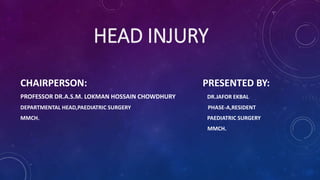Head injury.pptx
- 1. WELCOME
- 2. HEAD INJURY CHAIRPERSON: PRESENTED BY: PROFESSOR DR.A.S.M. LOKMAN HOSSAIN CHOWDHURY DR.JAFOR EKBAL DEPARTMENTAL HEAD,PAEDIATRIC SURGERY PHASE-A,RESIDENT MMCH. PAEDIATRIC SURGERY MMCH.
- 3. CONTENTS • Introduction • Defination • Mechanism of head injury • Different type of head injury • Assessment and investigation • Management • Reference • conclution
- 4. WHAT IS HEAD INJURY Trauma to scalp,skull,brain Injury may be bump on the skull or serious brain injury by external force
- 5. EPIDEMIOLOGY • Leading cause of death and disability • Accounts for 3-4% of emergency department attendances • 1500 cases per 100 000 population per year in UK
- 6. MECHANISM OF HEAD INJURY 1. Coup injuries :Direct impact against calvarium and brain 2. Countercoup injuries :Injuries on the side opposite to the impact 3. Penetrating injuries (gun shot)
- 8. CAUSES OF HEAD INJURY • RTA • Fall from height • Physical assault • Accident at home • Playing sports • Crush injury • Firearm
- 9. DIFFERENT TYPE OF INJURY • Scalp injury: * abrasion * laceration * contusion * subgalial hematoma • Skull injury: * linear skull fracture *depressed fracture * basilar fracture
- 10. ∞‰∞ø±∑∞’±ı±∑±´∑°‚Ķ‚∂ƒ¶.. ‚Ä¢ Brain injury: *concussion * contusion *diffuse axonal injury * intracranial hemorrhage(extradural,subdural,intracerebral)
- 11. SKULL FRACTURES • Linear fracture : * Low energy blunt trauma over a wide area of skull * thine line on x-ray. * do not require treatment. • Depressed fractures: * high energy force over a small area of skull. * may be open or closed. * indication for surgery are cosmesis. * intacranial haematoma requiring evacuation.
- 12. SCALP INJURY
- 14. ∞‰∞ø±∑∞’±ı±∑±´∑°‚Ķ‚∂ƒ¶.. ‚Ä¢ Basilar skull fracture : * linear fracture at base of the skull(frontal,temporal). * clinical sign are bleeding or CSF leak through ear(otorrhoea) or nose(rhinorrhoea) * bruising behind the ear(battle sign) or around the eyes(panda sign). * CSF leak will generally resolve spontaneously but persistent leak result meningitis so may be repaired. *blind NG tube placement is contraindicated
- 17. BRAIN INJURY • Concussion: *Alteration of consciousness due to closed head injury *due to trauma to brain from impact or sudden momentum *no imaging abnormality *may be lethargic, forgetful,slow to interact,gait disturbance,incoordination • Contusion: *bruise in the brain *due to vascular and tissue damage *rarely require surgical intervention
- 18. ∞‰∞ø±∑∞’±ı±∑±´∑°‚Ķ‚∂ƒ¶.. ‚Ä¢ Diffuse axonal injury: *form of primary brain injury *due to high energy accidents *patient may be comatose *strictly a pathologic diagnosis made at postmortem *CT often appears normal
- 19. BRAIN INJURY • Extradural haematoma: *hematoma forms between the skull and dura matter *due to fracture temporal bone,rupture artery(middle meningeal artery),vein or venous sinus *loss of consciousness with lucid interval,ipsilateral pupil dilatation *on CT hematoma appears lentiform(lens shaped or biconvex) *need urgent transfer to the accessible neurosurgical facility *prognosis for promptly evacuated extradural haematoma is excellent
- 21. ∞‰∞ø±∑∞’±ı±∑±´∑°‚Ķ‚∂ƒ¶. ‚Ä¢ Subdural haematoma : *haematoma between dura matter and subarachnoid space * high energy injury mechanism result in rupture of cortical vein with primary brain injury *developing sign of raised ICP *Rquire promt evacuation by craniotomy *mortality rate high
- 23. ∞‰∞ø±∑∞’±ı±∑±´∑°‚Ķ‚∂ƒ¶. ‚Ä¢ Intracerebral haemorrhage : *haemorrhage within the cerebral parenchyma *due to secondary to lacerations or contusions of brain, injury to larger,deeper cerebral vessels ‚Ä¢ Subarachnoid haemorrhage : *caused by laceration of the superficial microvesels in the subarachnoid space *if blood product obstruct arachnoid villi it may causes communicating hydrocephalus
- 24. GLASGOW COMA SCALE(PAEDIATRIC) Score Eye opening Verbal response Grimace response Motor response 1 None None None None 2 To pain Occational whimper/moan Mild to pain Extends to pain 3 To voice Inappropriate cry Vigorous to pain Flex to pain 4 Spontaneous Decreased verbal/irritable cry Less than usual face movement Withdraws 5 Alert babbles/word as normal Spontaneous face movement Localises pain 6 Obeys commands
- 25. INTERPRETATION OF GCS Minor head injury GCS 15 with no loss of consciusness Mild head injury GCS 14 or15 with LOC Moderate head injury GCS 9-13 Severe head injury GCS 3-8
- 26. INDICATIONS OF REFERRAL TO HOSPITAL OF CHILDREN 1. GCS<15 at any time since head injury 2. Any loss of consciousness as a result of injury 3. Any focal neurological deficit 4. Any seizure since injury 5. Persistent headache since injury 6. Suspician of skull fracture or penetrating head injury 7. CSF leak from the ear or nose 8. Multiple injury in association with head injury 9. Suspician of NAI 10. Amnesia before or after injury
- 27. INDICATION FOR CT SCAN AFTER HEAD INJURY 1. GCS<13 at any point since injury 2. Suspected open or depressed skull fracture 3. Any sign of basal skull fracture 4. Post traumatic seizure 5. Focal neurological deficit 6. Persistent vomiting 7. Amnesia greater than 5 min of events before impact
- 28. INDICATIONS OF SUSPECTED NON ACCIDENTAL HEAD INJURY IN CHILDREN • Suspicious and inconsistent story • History of previous injuries • Multiple cutaneous bruise of different age • Bilateral retinal haemorrhage • Acute subdural haemorrhage and brain swelling on CT scan • Bilateral skull fracture • Old fracture of long bones and ribs • Evidence of malnourishment • Subdued behaviour
- 29. ASSESSMENT AND DIAGNOSTIC EVALUATION • Details history about injury • Assessment • CT scan • X-ray • EEG • ABG • MRI • Cerebral angiography
- 30. MANAGEMENT • Medical therapies: *Restoration of normal BP *Intubation and ventilation *Elevation of head of bed *Keep head in neutral position *Sedation and muscular paralysis *normal fluid, electrolyte status,blood glucose,body temperature *Ventricular CSF drainage by ventricular catheter *Mannitol *High dose barbiturate
- 31. ∞‰∞ø±∑∞’±ı±∑±´∑°‚Ķ‚∂ƒ¶ ‚Ä¢ Surgical management : *Craniotomy *Vp shunting *Elevation of fragment in depressed skull fracture *Repair of CSF leakase
- 32. SEQUELE OF HEAD INJURIES IN CHILDREN • Chronic headache • Mental retardation • Growth failure • Learning disability • Memory loss • Epilepsy • CSF leak
- 33. PREVENTION AND HEALTH EDUCATION • Avoid driving after alcohol conjumption • Use seat belt during driving • Children less than 12 years should be restrained in an age appropriate system in back side • Motorcyclist,bicllists should wear helmets • Advice athlets to use protect device
- 34. REFERENCE • Bailey and love`s 27th edition • Jones` clinical Paediatric surgery 7th edition
- 35. THANK YOU


































